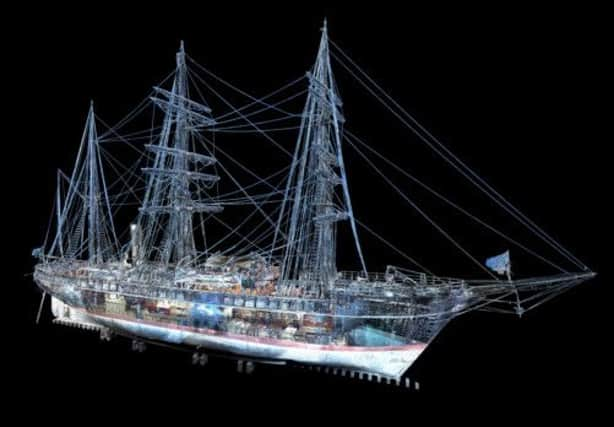Antarctic ship RSS Discovery scanned by 3D laser


The three masted vessel, launched to take Robert Falcon Scott and Ernest Shackleton on the successful British National Antarctic Expedition of 1901-04, has been scanned by a 3D laser for the first time as part of a project to help maintain the historic boat, now the star attraction at Dundee’s Discovery Point.
RSS Discovery, the first ship in the world to be specifically designed for polar scientific research, has already undergone some essential work which will help inform Dundee Heritage Trust of any future conservation needs.
Advertisement
Hide AdAdvertisement
Hide AdAnd the trust has now used the vessel’s recent stay in dry dock to prepare for work on the city’s £1 billion waterfront development, to capture the Discovery in 3D for the first time.
A trust spokesman explained: “A 3D laser scan will not only assist DHT in its on-going maintenance programme, it will also produce imagery which can be used to help with the public interpretation of the ship and her design features.
“Digital Surveys have been carrying out this work which will result in a photo realistic 3D model of the external hull, top deck and masts, a printed model of the ship and an online web based virtual tour. But essentially the scan will identify any deformation or movement of the ship, and be a significant piece of baseline information for future conservation monitoring and management purposes and will inform possible future engineering proposals regarding the cars and presentation of the ship.”
Mark Munsie, the operations director of DHT, said: “RRS Discovery is showing signs of structural movement which is evidence in the form of cracks opening between timbers at various locations around the ship.
Advertisement
Hide AdAdvertisement
Hide AdThis project will create an accurate and complete 3D digital record of the external shape of the vessel and provide evidence of any movement or structural deformation.“
He added: “We are extremely grateful for the support of Museums Galleries Scotland who have provided funding for this study under the Recognition scheme.”
Virtual snapshot
Ben Bennett, Chief Technology Officer from Digital Surveys said: “Digital Surveys are delighted to be working on such a prestigious heritage project. We will be using the latest 3D laser scanning technology to digital capture the vessel creating a virtual snapshot in time.
“Laser scanning is perfect for this type of project capturing billions of points of information and allowing many different deliverables to be created. This should provide a fantastic 3D data resource in the on-going preservation of the RRS Discovery.”
Advertisement
Hide AdAdvertisement
Hide AdThe RRS Discovery was built by the Dundee Shipbuilders Company as a specialist research vessel, designed for work in Antarctic waters, with her design based on the great Dundee whalers.She was one of the last three-masted wooden sailing ships to be built in Britain.
She returned to her home port to become one of Dundee’s top visitor attractions in 1986. The Discovery is now part of the UK’s historic fleet collection.
SEE ALSO: